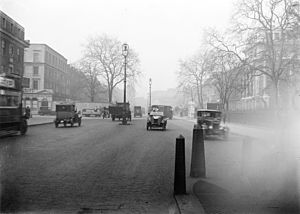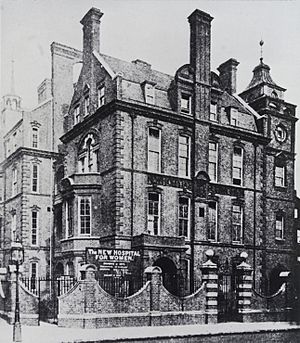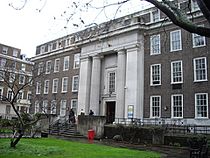Euston Road facts for kids
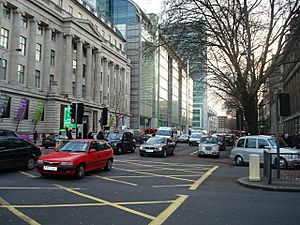
Euston Road in 2008
|
|
| Other name(s) | |
|---|---|
| Former name(s) | New Road |
| Namesake | Euston Hall |
| Length | 1.1 mi (1.8 km) |
| Postal code | W1, NW1 |
| Coordinates | 51°31′39″N 0°07′53″W / 51.5275°N 0.131389°W |
| West end | Great Portland Street |
| East end | Pentonville Road |
| Construction | |
| Inauguration | September 1756 |
Euston Road is a busy street in Central London. It stretches from Marylebone Road to King's Cross. This road is part of the London Inner Ring Road. It also marks the edge of the London congestion charge zone. The road gets its name from Euston Hall. This was the country home of the Dukes of Grafton. They owned a lot of land in the area during the 1800s.
Euston Road was first called New Road. It opened in 1756 as London's first bypass. This new route helped farmers drive their cattle to Smithfield Market. They could avoid the busy streets of central London. Traffic grew a lot when big railway stations opened in the mid-1800s. These included Euston. Because of this, the road was renamed Euston Road in 1857. In the 1960s, Euston Road was made wider for more cars. The Euston Tower was also built around this time. Today, the road is home to important buildings. These include the Wellcome Library, the British Library, and the St Pancras Renaissance London Hotel.
Contents
Exploring Euston Road's Location
Euston Road is a key part of the A501, a main road in Central London. It begins where Marylebone Road and Great Portland Street meet. Further along, it connects with the northern end of Tottenham Court Road. This is a big junction with an underpass for traffic. The road finishes at King's Cross, meeting Gray's Inn Road. The road that continues towards Islington is Pentonville Road.
This road is part of London's main inner ring road. It sits on the edge of the London congestion charge zone. You don't pay to drive on Euston Road itself. But you might if you turn south into the zone during its operating hours.
Why are London's Big Train Stations Here?
King's Cross and St Pancras stations are at the eastern end of Euston Road. Euston railway station is a bit further west. These three major train stations are located here for a reason. In 1846, a special group decided where new railway stations should be. They wanted to protect the fancy West End areas. So, they suggested placing the stations a short distance north of those areas, along what is now Euston Road.
Landmarks and Transport on Euston Road
The Euston Tower is a tall building that stands out on the road. The British Library is located just west of St Pancras station. The old and new buildings of the Wellcome Trust are on the south side of the road.
As you travel along Euston Road, you'll pass several tube stations. These include Regent's Park, Great Portland Street, Warren Street, Euston Square, Euston, and King's Cross St Pancras. Bus routes 30 and 205 travel the entire length of Euston Road.
Euston Road's Past: A Timeline
How Euston Road Began (1700s-1800s)
Before the 1700s, the land where Euston Road now runs was mostly farms and fields. Camden Town was a quiet village where Londoners went to relax. Euston Road was originally part of New Road. Its creation was supported by Charles FitzRoy, 2nd Duke of Grafton. A special law was passed in 1756 to allow its construction. Building started in May 1756, and the road was open by September.
The road was built to help farmers. They could move their sheep and cattle to Smithfield Market without going through Oxford Street and Holborn. It also offered a faster way for the army to reach the Essex coast. This was important if there was a threat of invasion. The road also acted as a barrier. It stopped London's growing city from spreading into places like Camden Town.
A rule in the 1756 law said that no buildings could be built within 50 feet (about 15 meters) of the road. This meant most houses along it had large gardens in front. However, this rule was often ignored in the 1800s.
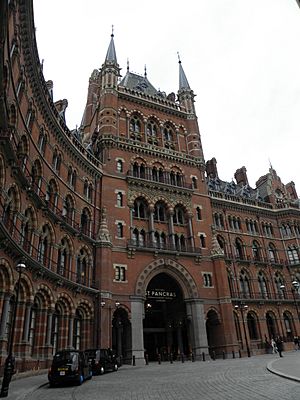
Euston station opened on the north side of New Road in July 1837. It was designed by Robert Stephenson. This was London's first major train station. Its grand entrance, designed by Philip Hardwick, was very impressive. The Great Hall was added in 1849 for passengers.
By 1857, the Dukes of Grafton owned most of the land in the area. So, the middle part of the road was renamed Euston Road. It was named after their country home, Euston Hall. The eastern part became Pentonville Road, and the western part became Marylebone Road.
The entire length of Euston Road was dug up to build the Metropolitan Railway underneath it. This was done using a "cut-and-cover" method. The road was then rebuilt to a much better standard. St Pancras railway station opened in 1867. The beautiful Midland Grand Hotel (now St Pancras Renaissance London Hotel) opened in 1873. Sadly, the original Euston station was taken down in 1963. A new building opened in 1968. Today, it serves 50 million passengers each year.
Euston Road in the Modern Era (1900s-2000s)
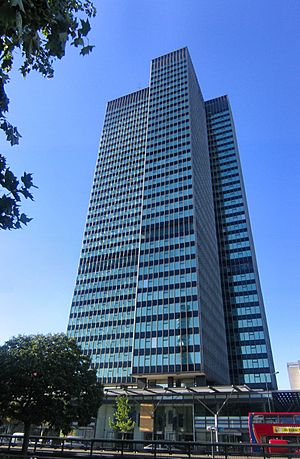
The area around the Tottenham Court Road junction was heavily damaged during The Blitz in World War II. After the war, there were plans to build a new ring road around Central London. Instead, existing roads, including Euston Road, were improved to form this ring.
In 1959, an underpass was suggested to help traffic flow better at the Tottenham Court Road junction. Construction began in 1964. A property developer named Joe Levy bought land in the area. He wanted to build new buildings. The council refused his plans at first because of the underpass. Eventually, an agreement was reached. The council built the underpass, and Levy built a complex of two tall buildings, the Euston Tower.
The Euston Tower attracted important businesses. These included Inmarsat and Capital Radio. The TV company Thames Television had its main office nearby from 1971 to 1992.
In the early 2000s, a plan was made to improve Euston Road. It aimed to change the road from just a highway into a series of connected public spaces. A new pedestrian crossing opened in March 2010.
In 2015, Transport for London announced plans to close one lane in each direction on Euston Road. This would happen between 2020 and 2026. It is to make way for work on High Speed 2, a new train line. This decision was criticized by the local council. They worried it would harm businesses and cost a lot of money.
Important Buildings on Euston Road
About halfway along Euston Road, you'll find St Pancras New Church. It was built in 1822. This church was very expensive for its time. Almost directly across from it is the Euston Road fire station, built in 1901–2. The Shaw Theatre opened at No. 100–110 in 1971. It was named after the writer George Bernard Shaw.
The New Hospital for Women moved to No. 144 Euston Road in 1888. It was special because it was staffed entirely by women. This made it a comfortable place for women patients. It was renamed the Elizabeth Garrett Anderson Hospital in 1918. This was in honor of Elizabeth Garrett Anderson, England's first female doctor. The hospital moved its services in 1993.
The Wellcome Trust is a charity that supports medical research. It has buildings at No. 183 and No. 210 Euston Road. Its library holds about half a million books. This includes many old manuscripts and medical documents.
In late 1898, a Mosque was located at 189 Euston Road. It was run by Hajie Mohammad Dollie. This was one of London's first mosques.
The Midland Grand Hotel, which faces St Pancras station, was designed by George Gilbert Scott. It is a beautiful building made mostly of red bricks. It closed in 1935 and was almost torn down many times. Luckily, it was saved and became a protected building in 1967. After a big restoration, the hotel reopened as the St Pancras Renaissance London Hotel in 2011.
Camden Town Hall, which used to be St Pancras Town Hall, opened in 1937. The headquarters of the Religious Society of Friends, also known as Quakers, is at Friends House, No. 173 Euston Road. It was built between 1925 and 1927. It holds the society's library, which dates back to 1673.
The British Library moved to No. 96 Euston Road in 1999. It is a large, modern building designed by Colin St John Wilson. It was opened by Queen Elizabeth II. The building used over ten million bricks and has a huge floor area. Even though some critics didn't like its design, many visitors enjoy its welcoming entrance and how well it is organized inside. Around 16,000 people visit the British Library every day.



